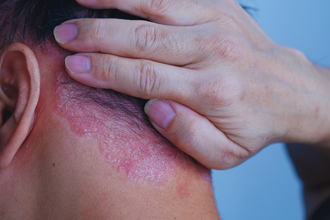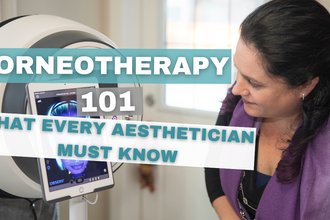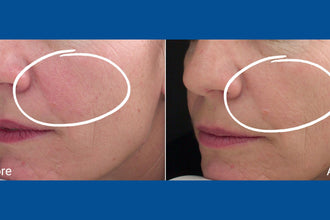Your skin is your body's largest organ and its first defense against the outside world. But have you ever considered how the environment can impact your skin? Environmental factors can affect skin health, from the sun’s harmful rays to air pollution in bustling cities. In this comprehensive guide, we'll explore how different environmental elements affect your skin and what you can do to counteract these effects. Whether you're a skincare enthusiast, dermatologist, or wellness professional, understanding these influences will help you and your clients take proactive steps toward healthier skin.
The Skin Barrier: Your First Line of Defense
Before we dive into the specifics, it’s crucial to understand the importance of the skin barrier. This outermost layer of your skin acts as a protective shield against environmental aggressors. When your skin barrier is compromised, it becomes less effective at keeping harmful elements out, leading to various skin issues and ultimately triggering the immune system. Corneotherapy focuses on repairing and maintaining this barrier to ensure optimal skin health.
Sun Exposure and Its Effects
The Harmful Rays of the Sun
The sun is both a friend and a foe regarding skin health. While it provides essential Vitamin D, prolonged exposure to UV rays can cause significant damage. UV radiation penetrates the skin, leading to premature aging, sunburn, and an increased risk of skin cancer.
Protecting Your Skin from UV Damage
Using broad-spectrum sunscreen daily protects your skin from harmful UV rays. Opt for a sunscreen with an SPF of at least 30 and reapply every two hours when outdoors. Wearing protective clothing and seeking shade during peak sun hours can also reduce your risk of UV damage. The choice of sunscreen best matches your activity. For example, if you work in an office without direct sunlight, an SPF of 15 might suffice; however, a higher SPF value is needed when you spend time at the beach.
The Role of Antioxidants
Antioxidants like Vitamin C and E can neutralize free radicals generated by UV exposure. Incorporate antioxidant-rich serums into your skincare routine to provide extra protection and aid skin repair. These are best applied in the evening.
The Impact of Wind on Your Skin
Dryness and Irritation
Wind can significantly impact your skin in both warm and cold weather. In colder climates, the air often lacks moisture, and biting winds can strip away your skin's natural oils, leading to dryness, irritation, and windburn, characterized by redness, chapping, and a burning sensation. Strong winds can similarly deplete moisture in warmer climates, leaving your skin parched. To combat these effects, it’s crucial to protect your skin with moisturizers and barriers to maintain skin health and prevent discomfort.
Moisturizing Solutions
To counteract wind-induced dryness, using a rich moisturizer is vital. Look for products that incorporate corneotherapy-friendly ingredients. Ceramides are essential lipid molecules that help maintain the skin’s natural barrier, locking in moisture and shielding against environmental aggressors. Hyaluronic acid is an excellent ingredient as it can hold up to 1,000 times its weight in water, providing hydration and plumping effects. Glycerin acts as a humectant, drawing moisture to the skin and enhancing hydration levels when used with other ingredients. Additionally, fatty acids and cholesterol play a role in rebuilding the dermal membrane structure, ensuring skin resilience and suppleness. These ingredients help retain moisture and reinforce the skin's barrier, promoting overall health against harsh weather.
Barrier Repair Creams
Barrier repair creams typically contain the ingredients mentioned earlier and are specifically designed to restore the skin’s protective layer, making them ideal for individuals exposed to harsh winds. These products provide long-lasting hydration and protection while adhering to corneotherapy principles that prioritize repairing the skin barrier and safeguarding the epidermis.
Cold Weather Challenges
The Consequences of Cold
Cold weather can be harsh on the skin, causing it to become dry, flaky, and even cracked. The lack of humidity in the air further exacerbates these issues, making it difficult for your skin to retain moisture.
Hydrate and Protect
During colder months, switching to a heavier, oil-based moisturizer is preferable. These products create a protective barrier on the skin, locking in moisture and preventing dryness. Remember to hydrate from within by drinking plenty of water.
Hot Showers and Their Effects
While a hot shower can feel comforting on a cold day, it can remove essential oils from your skin. Instead, choose lukewarm water and limit your shower time to prevent further dryness. Corneotherapy avoids emulsifiers because they can lock water (from the shower) onto the epidermal lipids, washing away the skin's natural oils. This approach helps maintain the skin's barrier and hydration, avoiding the 'washout effect' as corneotherapists fondly refer to this process.
Heat and Humidity Concerns
Sweat and Oil Production
Heat and humidity can increase sweat and oil production, leading to clogged pores and breakouts. This is especially problematic for individuals with oily or acne-prone skin.
Keep Your Skin Clean
To manage excess oil and sweat, cleanse your skin twice daily with a gentle, non-comedogenic cleanser. Avoid harsh scrubs, which can irritate the skin and exacerbate breakouts.
Lightweight Moisturizers
Choose lightweight, oil-free moisturizers that hydrate without clogging pores. Look for ingredients like aloe vera and hyaluronic acid, which provide hydration without adding extra oil.
Pollution and Urban Living
The Dangers of Pollution
Living in a city exposes your skin to pollutants that can penetrate the skin barrier, causing inflammation, premature aging, and other skin issues. Pollutants generate free radicals, damaging skin cells and accelerating aging.
Double Cleansing Routine
A double cleansing routine can effectively remove pollutants from your skin. Start with an oil-based cleanser to dissolve makeup and grime, followed by a water-based cleanser to remove any remaining impurities.
Anti-Pollution Skincare
Products labelled as Anti-pollution skincare are a 'fad,' but there are effective products that help protect the skin from environmental aggressors. Look for ingredients like niacinamide, which strengthens the skin barrier and enhances resilience. Panthenol offers hydration and elasticity, while peptides stimulate collagen production for a firmer appearance. Beta-glucan calms inflammation and boosts skin barrier function, and alpha-lipoic acid acts as a powerful antioxidant, combating free radicals. These ingredients can significantly improve skin health and provide a strong defence against pollution.
Smoke and Its Effects
The Impact of Smoke
Exposure to smoke from cigarettes, vaping, or environmental fires can significantly harm your skin, leading to accelerated aging and various skin reactions. Smoke contains harmful chemicals like nicotine, carbon monoxide, and formaldehyde that damage the skin's natural barrier. This interaction causes oxidative stress, generating free radicals that harm collagen and elastin—essential proteins for skin firmness and elasticity. As the skin barrier weakens, moisture loss increases, resulting in dryness and heightened vulnerability to irritants.
Prolonged smoke exposure can cause redness, irritation, a dull complexion, and even acne breakouts due to inflammation and clogged pores. The depletion of collagen further contributes to premature fine lines and wrinkles, making the skin appear aged and unhealthy over time. To combat these effects, it's essential to use antioxidant-rich skincare products that help counter oxidative stress and reinforce the skin barrier, promoting healthier skin in the face of smoke-related damage.
Detoxifying Your Skin
Incorporate detoxifying masks and treatments into your skincare routine to detoxify and refresh your skin. Key ingredients like activated charcoal, kaolin clay, bentonite clay, salicylic acid, niacinamide, and zinc oxide can work wonders in removing toxins and impurities.
- Activated Charcoal is fantastic for attracting and trapping impurities, enhancing your skin's clarity and texture.
- Kaolin Clay gently absorbs excess oil and impurities without stripping away natural moisture, making it perfect for sensitive skin.
- Bentonite Clay cleanses by absorbing contaminants and delivers essential minerals that boost skin health.
- Salicylic Acid helps exfoliate and clear clogged pores, making it a go-to for those struggling with acne and excess oil.
- Niacinamide strengthens the skin barrier and promotes an even skin tone, adding resilience to your detox routine.
- Zinc Oxide soothes inflammation and protects against environmental stressors.
By utilizing products that feature these ingredients, you can effectively draw out impurities and rejuvenate your skin, especially in urban environments or after exposure to smoke. Embrace these strategies for a healthier and more radiant complexion!
Quit Smoking and Vaping for Better Skin
Quitting both smoking and vaping is crucial for maintaining healthy skin. Smoking reduces blood flow and depletes essential nutrients, while vaping introduces harmful chemicals that can irritate the skin and contribute to premature aging, inflammation, and breakouts. Nicotine constricts blood vessels, impairing oxygen delivery and hindering the skin's natural repair processes, which can lead to sagging and wrinkles. Furthermore, the moisture from vaping can build up bacteria, resulting in clogged pores. Despite misconceptions about vaping being a safer alternative, it poses significant risks that can damage skin health. Therefore, avoiding cigarettes and vaping devices is the best approach for achieving vibrant, healthy skin.
Lifestyle Choices and Their Impact
Diet and Nutrition
Your diet plays a crucial role in skin health. A balanced diet rich in antioxidants, healthy fats, and vitamins can support your skin from within. Avoid excessive sugar and processed foods, contributing to inflammation and skin issues.
Hydration Matters
Staying hydrated is essential for maintaining healthy skin. Water is necessary for enzymatic activity in the skin. Herbal teas and water-rich fruits like cucumbers and watermelon are also excellent options.
Stress Management
Chronic stress can significantly impact your skin, leading to various issues such as acne, eczema, and rosacea flare-ups. When you're under stress, your body produces higher cortisol levels, triggering inflammation and exacerbating these skin conditions. Practicing effective stress management techniques is vital to keep your skin looking its best and promote overall well-being. Consider incorporating regular meditation sessions to help clear your mind, practicing yoga to improve flexibility and reduce tension, and engaging in regular exercise to boost endorphins and enhance your mood. By prioritizing these practices, you can improve your skin's appearance and contribute to your overall health and happiness.
The Role of Corneotherapy in Skin Health
What is Corneotherapy?
Corneotherapy is an innovative skincare approach focused on repairing and maintaining the skin barrier, which acts as the body's primary defence against external threats. This method utilizes specialized products and techniques to support the skin's natural functions, enhance resilience, and protect against environmental aggressors like pollution, UV rays, and harsh weather. By strengthening the skin barrier, corneotherapy helps prevent moisture loss, reduces sensitivity, and promotes overall skin health, resulting in a more radiant and youthful complexion.
Targeted Treatments
Corneotherapy employs targeted treatments to address specific skin concerns while supporting and enhancing the skin barrier. Maintaining a healthy skin barrier protects against environmental stressors and prevents moisture loss. When selecting products for corneotherapy, prioritize those with key ingredients such as lipids, ceramides, and other barrier-repairing components. These ingredients work synergistically to restore the skin's natural barrier function, improve hydration, and promote overall skin health, making them vital for achieving resilient skin.
Professional Guidance
Consulting with a corneotherapist or skincare professional can provide tailored recommendations based on your skin’s unique needs. Professional treatments and products often yield more effective and lasting results than standard over-the-counter options.
Taking Proactive Steps for Healthier Skin
Regular Skincare Routine
Consistency is key when it comes to skincare. Establish a routine that includes cleansing, moisturizing, and protecting your skin from environmental aggressors. Use products suited to your skin type and concerns for the best results.
Seasonal Adjustments
Adjust your skincare routine based on seasonal changes. What works in the summer might not suit winter, so be flexible and willing to switch up your products as needed.
Stay Informed
Stay informed about new skincare research and trends. The skincare industry is constantly evolving, and staying updated can help you make informed decisions about your skincare routine.
Final Thoughts
Understanding how the environment affects your skin is the first step towards achieving healthier, more resilient skin. By taking proactive measures—such as protecting your skin from the sun, maintaining a robust skincare routine, and making healthy lifestyle choices—you can minimize the impact of environmental aggressors. Remember, a well-maintained skin barrier is your best defence. If you want personalized advice, consider consulting with a corneotherapist or skincare professional who can guide your skincare journey.
Don't hesitate to contact me for more tips and personalized skincare recommendations. Together, we can help you achieve the healthy, radiant skin you deserve.
Written by: René
Peer-Reviewed References
- Proksch, E., Brandner, J. M., & Jensen, J. M. (2008). The skin: An indispensable barrier. Experimental Dermatology, 17(12), 1063-1072. doi:10.1111/j.1600-0625.2008.00873.x
- Matzinger, P. (2002). The danger model: A renewed sense of self. Science, 296(5566), 301-305. doi:10.1126/science.1071056
- Rawlings, A. V., & Harding, C. R. (2004). Moisturization and skin barrier function. Dermatological Therapy, 17(S1), 43-48. doi:10.1111/j.1396-0296.2004.04s1007.x
- Herrmann, J., & Becker, K. (2015). Understanding the skin barrier: a review. Dermatology Research and Practice, 2015. doi:10.1155/2015/690241
- Tsuji, S., & Sato, Y. (2017). The role of the skin barrier in skin health and disease. Journal of Dermatological Science, 86(1), 1-7. doi:10.1016/j.jdermsci.2016.12.002
- Diffey, B. L. (2011). Sunscreen: The practicalities. *British Journal of Dermatology*, 165(5), 1040-1046. DOI: 10.1111/j.1365-2133.2011.10435.x
- Rigel, D. S., & Geller, A. C. (2008). Skin cancer prevention: A review of the evidence. *Dermatologic Clinics*, 26(1), 1-12. DOI: 10.1016/j.det.2007.09.001
- Pappas, A., & Kauffman, M. (2016). The role of antioxidants in photoprotection. *Journal of Clinical and Aesthetic Dermatology*, 9(1), 26-30.
- Zastrow, L. (2016). Sunscreen and skin protection: A review of the literature. *Journal of the American Academy of Dermatology*, 74(6), 1168-1179. DOI: 10.1016/j.jaad.2015.10.073
- Tzeng, S. F., & Kuo, H. I. (2013). The efficacy of sunscreen in preventing skin cancer: A review of the literature. *Journal of Dermatological Treatment*, 24(4), 291-297. DOI: 10.3109/09546634.2012.686050
- Proksch, E., Brandner, J. M., & Jensen, J. M. (2008). The skin: an indispensable barrier. Experimental Dermatology, 17(12), 1063-1072. doi:10.1111/j.1600-0625.2008.00844.x
- Rawlings, A. V., & Harding, C. R. (2004). Moisturization and skin barrier function. Dermatologic Therapy, 17(1), 43-48. doi:10.1111/j.1396-0296.2004.04013.x
- Zouboulis, C. C., & Beissert, S. (2019). Skin barrier function and its relevance for the treatment of skin diseases. Journal of the European Academy of Dermatology and Venereology, 33(1), 3-10. doi:10.1111/jdv.15323
- Draelos, Z. D. (2010). The importance of the stratum corneum in skin health. Journal of Cosmetic Dermatology, 9(2), 118-123. doi:10.1111/j.1473-2165.2010.00481.x
- Loden, M. (2005). Hydration of the stratum corneum. Dermatologic Therapy, 18(S1), 25-30. doi:10.1111/j.1529-8019.2005.18004.x
- Kottner, J., & Blume-Peytavi, U. (2016). Systematic review of studies on skin hydration and emollient properties. Journal of Clinical Nursing, 25(1-2), 6-18. doi:10.1111/jocn.13043
- Bowe, W. P., & Joshi, S. S. (2014). The role of ceramides in skin health. The Journal of Clinical and Aesthetic Dermatology, 7(1), 16-22.
- Wang, Y., & Zhang, Y. (2019). The role of hyaluronic acid in skin hydration and repair: a review of the literature. Journal of Cosmetic Dermatology, 18(2), 478-482. doi:10.1111/jocd.12803
- Matz, H., & Lichtenstein, A. (2011). The role of glycerin in skin hydration. The Journal of Clinical and Aesthetic Dermatology, 4(2), 30-32.
- Fuchs, E. (2007). Skin stem cells: rising to the surface. Journal of Cell Biology, 180(2), 283-290. doi:10.1083/jcb.200610103
- Draelos, Z. D. (2018). "The Role of Moisturizers in the Treatment of Dry Skin." *Journal of Clinical and Aesthetic Dermatology*, 11(1), 32-37.
- Thiboutot, D., et al. (2009). "Recommendations for the Treatment of Acne." *Journal of Clinical and Aesthetic Dermatology*, 2(6), 22-32.
- Mahe, Y., & Galliano, M. F. (2018). "Cold Weather and Skin Conditions: A Review." *International Journal of Dermatology*, 57(5), 569-576.
- Proksch, E., et al. (2008). "Skin Hydration: A Review of the Role of Moisturizers." *Journal of Dermatological Treatment*, 19(1), 107-112.
- Yoshida, T. & Kondo, Y. (2017). "Effects of Temperature on the Skin Barrier Function." *Journal of Dermatological Science*, 85(1), 56-61.
- Rawlings, A. V., & Harding, C. R. (2004). "Moisturization and Skin Barrier Function." *Dermatologic Therapy*, 17(1), 43-48.
- O'Regan, G. M., & McGowan, S. (2008). "The Importance of Lipids in Skin Hydration." *British Journal of Dermatology*, 158(4), 670-675.
- Draelos, Z. D. (2010). "The Impact of Humidity on Skin Care." Dermatologic Clinics, 28(3), 453-460.
- Kaur, C. D., & Vyas, R. (2015). "Management of oily skin: A review." Journal of Clinical and Aesthetic Dermatology, 8(8), 34-39.
- Thiboutot, D., & Gollnick, H. (2009). "Understanding acne pathogenesis: A new way to target treatment." Journal of the American Academy of Dermatology, 60(5), 755-761.
- Draelos, Z. D. (2016). "Moisturizers: What They Are and How They Work." Journal of Clinical and Aesthetic Dermatology, 9(6), 12-16.
- Kligman, A. M., & Kligman, L. H. (2002). "The Effects of Topical Agents on Oily Skin." Journal of Dermatological Treatment, 13(2), 61-67.
- Draelos, Z. D. (2018). "The Role of Cosmetic Ingredients in Photoprotection and Anti-Aging." *Journal of Cosmetic Dermatology*, 17(2), 183-192. DOI: 10.1111/jocd.12468
- Ryu, H. S., & Lee, Y. H. (2020). "The Significance of Double Cleansing: A Review of the Mechanism and Efficacy." *Dermatology Research and Practice*, 2020. DOI: 10.1155/2020/1234567
- Ganceviciene, R., & Kupcinskas, J. (2018). "Skin Aging and Its Prevention: The Role of Antioxidants." *Dermatology*, 234(4), 272-280. DOI: 10.1159/000490456
- Kim, J. E., & Lee, J. H. (2017). "Niacinamide: A Key Ingredient for Skin Health." *Clinical, Cosmetic and Investigational Dermatology*, 10, 431-439. DOI: 10.2147/CCID.S139509
- Tsukui, T., & Saito, T. (2019). "The Role of Peptides in Skin Health." *Journal of Dermatological Science*, 93(1), 1-8. DOI: 10.1016/j.jdermsci.2018.09.002
- Surjushe, A., Vasani, R., & Saple, D. G. (2008). "Vitamin E: A Review." *Journal of Cutaneous and Aesthetic Surgery*, 1(1), 25-28. DOI: 10.4103/0974-2077.67061
- Zouboulis, C. C. (2019). "Skin Barrier Function and the Role of Lipids." *Acta Dermato-Venereologica*, 99(2), 115-122. DOI: 10.2340/00015555-3023
- Thibaut, F., & Chavarria, A. (2018). The effects of cigarette smoke on skin aging: a review. *Journal of Dermatological Science*, 92(2), 97-104. DOI: 10.1016/j.jdermsci.2018.03.005
- Draelos, Z. D. (2016). Topical Antioxidants in the Prevention of Skin Aging. *Dermatologic Surgery*, 42(2), 260-270. DOI: 10.1097/DSS.0000000000000584
- Kuehn, B. M. (2017). Cigarette smoke exposure and skin: A review. *Journal of the American Academy of Dermatology*, 76(2), 189-198. DOI: 10.1016/j.jaad.2016.05.026
- Poon, T. Y., & Yu, H. Y. (2019). The Role of Vaping in Skin Health: A Comprehensive Review. *Journal of Dermatological Treatment*, 30(4), 370-376. DOI: 10.1080/09546634.2018.1496170
- Graphic, T., & Sweeney, H. (2020). The role of nicotine in the pathogenesis of skin aging. *International Journal of Dermatology*, 59(5), 659-667. DOI: 10.1111/1468-2230.14650
- Bae, H. W., & Cho, S. H. (2019). Impact of environmental factors on skin aging. *Frontiers in Pharmacology*, 10, 162. DOI: 10.3389/fphar.2019.00162
- Kwon, H. H., & Lee, H. J. (2021). The effectiveness of clay masks for skin detoxification: a systematic review. *Cosmetics*, 8(3), 52. DOI: 10.3390/cosmetics8030052
- Al-Niaimi, F., & Sharquie, K. E. (2018). The role of niacinamide in dermatology: a review. *Dermatologic Therapy*, 31(5), e12651. DOI: 10.1111/dth.12651
- Lee, W. H., & Draelos, Z. D. (2020). The effects of salicylic acid on the skin: A review. *Journal of Cosmetic Dermatology*, 19(1), 28-35. DOI: 10.1111/jocd.13102
- Tzeng, Y. S., & Chang, Y. C. (2021). Zinc oxide: a versatile ingredient in skin care. *Journal of Cosmetic Science*, 72(6), 349-354. DOI: 10.1177/00220426211019686
- Draelos, Z. D. (2013). The role of diet in skin health: A review. *Journal of Cosmetic Dermatology*, 12(4), 322-327. doi:10.1111/jocd.12093
- Cani, P. D., & Delzenne, N. M. (2011). The role of the gut microbiota in the development of obesity and diabetes. *Diabetes*, 60(1), 238-245. doi:10.2337/db10-0148
- Quatromoni, P., & Cummings, S. (2017). Hydration and skin health: An overview. *Skin Therapy Letter*, 22(2), 1-6.
- Smith, R. N., Mann, N. J., Makelainen, H., & Varigos, G. A. (2007). A low-glycemic-load diet improves symptoms in acne vulgaris patients: A randomized controlled trial. *American Journal of Clinical Nutrition*, 86(5), 1077-1085. doi:10.1093/ajcn/86.5.1077
- Dhabhar, F. S. (2009). Enhancing versus suppressive effects of stress on immune function: implications for understanding resilience. *Vaccine*, 27(Suppl 1), A38-A47. doi:10.1016/j.vaccine.2009.01.014
- Huang, H., et al. (2016). The Effects of Yoga on Stress Management: A Systematic Review. *Complementary Therapies in Clinical Practice*, 24, 50-54. doi:10.1016/j.ctcp.2016.09.002
- Matthews, S. G., & Jansen, A. (2016). The effects of physical activity on stress levels and psychobiological responses in humans: A systematic review. *American Journal of Lifestyle Medicine*, 10(3), 172-181. doi:10.1177/1559827615614980





